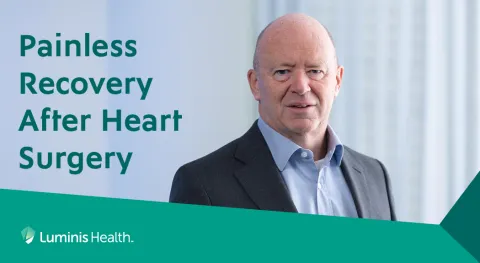
While traveling for work several years ago, Bruce Ingram of Nottingham, Maryland, noticed that he had an irregular heartbeat. His partner, Kimberly, is a nurse with many years of experience treating cardiac conditions, and she suggested they go to the emergency room.
At the ER, doctors determined that he was in atrial fibrillation (Afib) but had a very slow heart rate. They recommended he receive a permanent pacemaker, a surgically implanted device that sends electrical impulses to the heart to maintain a normal beating rate.
Nearly a decade later, Ingram remained active by running and swimming, but he still experienced fatigue and loss of energy, common symptoms of Afib. An echocardiogram (ultrasound of the heart) also showed his heart was weakening. Kimberly recommended that they seek a permanent solution under the care of her former colleague, Dr. Murtaza Dawood, a cardiothoracic surgeon at Luminis Health.
Dr. Dawood proposed a hybrid surgical ablation. “Mr. Ingram’s atrial fibrillation is not only contributing to his symptoms, but is most likely causing his weakened heart function. We can treat his atrial fibrillation by surgical ablation to create scarring in the heart muscle. These scars can prevent the normal heart electrical activity from persisting as atrial fibrillation,” he explained. “By restoring a normal heart rhythm, we can improve his symptoms, and with time, his overall heart function.”
The hybrid approach combines minimally invasive surgical ablation with a catheter-based ablation to be done three months later. “The Convergent+ procedure combines two minimally invasive procedures to maximize the benefit to the patient” says Dr. Dawood. “Additionally, to further minimize Mr. Ingram’s risk of stroke, I placed a closure device on his left atrial appendage, also done minimally invasively. That’s the ‘plus’ part of the procedure.” Approximately 90% of strokes associated with Afib originate from the left atrial appendage.
In January 2022, Dr. Dawood performed the surgical ablation stage on Ingram, with the catheter ablation done 12 weeks later. More than two years later, Ingram reports a complete change since the surgery. He can run, swim, and travel for work without any issues from Afib. This past summer, he and Kimberly visited Yellowstone National Park and enjoyed several hikes around the park.
If you are seeking care for Afib, please visit Luminis.Health/HeartSurgery or call (443) 481-1358 to learn about surgical options for treatment.



